Brent Marchant's Blog, page 97
January 29, 2018
‘The Post’ examines what it takes to do the right thing
“The Post” (2017). Cast: Meryl Streep, Tom Hanks, Sarah Paulson, Bob Odenkirk, Tracy Letts, Bradley Whitford, Bruce Greenwood, Matthew Rhys, Alison Brie, Carrie Coon, Jesse Plemons, Michael Stuhlbarg, Justin Swain, Curzon Dobell. Director: Steven Spielberg. Screenplay: Liz Hannah and Josh Singer. Web site. Trailer.
When faced with hard choices, we may not know which way to turn. That’s especially true when all of our options appear problematic. Deciding which of the seemingly troublesome outcomes will prove least onerous can try our patience and test our resolve. At the same time, though, such scenarios can sharpen our scrutiny skills, especially when it comes to drawing upon our intuition and integrity to arrive at an amenable solution. So it was for a group of media professionals who found themselves with their backs up against the wall as seen in the new fact-based journalism drama, “The Post.”
In 1971, The Washington Post was going through a bumpy transition period. The family-owned newspaper, managed by publisher Kay Graham (Meryl Streep), was in the process of going public to improve its financial position. But, to help make the publication a more attractive investment option, the paper also needed to look at upping its editorial profile, one more in line with the first-class reporting reputation it was seeking to cultivate, a responsibility assumed by editor Ben Bradlee (Tom Hanks). This was vital in light of the changing journalism marketplace, with more major newspapers, like The New York Times, taking on more of a national – and not just a local – presence. If the Post didn’t act, it could be left in the dust by other publications, threatening the company’s future.
The opportunity to advance the paper’s coverage came with the release of the Pentagon Papers, a 7,000-page collection of covert documents detailing the U.S. role in Vietnam – not just during the war but in the two decades preceding it, going as far back as the Truman administration. Through this disclosure by military analyst Daniel Ellsberg (Matthew Rhys), it became apparent that American interference in Vietnamese affairs was pervasive, with extensive involvement in the Asian nation’s politics, economics and society. The damning disclosure also documented the futility underlying the U.S. war effort, a campaign that continued despite insider knowledge of this inherent problem and increasingly vocal domestic disapproval of the conflict.
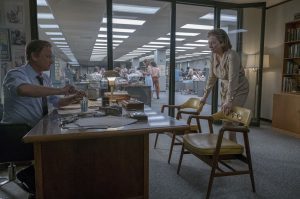
Washington Post publisher Kay Graham (Meryl Streep, right) and editor Ben Bradlee (Tom Hanks, left) discuss the paper’s precarious future in director Steven Spielberg’s latest, “The Post.” Photo by Nick Tavernise, courtesy © Twentieth Century Fox Film Corporation and Storyteller Distribution Co. LLC.
The story was initially broken by New York Times reporter Neil Sheehan (Justin Swain). However, given the bombshell nature of these revelations, the Nixon administration quickly came down hard on the Times, imposing an injunction against it from publishing any further material from the secret report, given that it was allegedly leaked in violation of the federal Espionage Act. With the Times’s hands tied, this opened the door for the Post, especially when Ellsberg was identified as the source of the leak: As a former colleague of Post assistant managing editor Ben Bagdikian (Bob Odenkirk), Ellsberg found a new outlet for making additional disclosures.
Needless to say, given the magnitude of the story, Bradlee and Bagdikian jumped at the chance to pick up the gauntlet and continue publishing articles about the Pentagon Papers. However, considering that the Post’s source was the same as that of the Times, the paper soon found itself in the same position as its New York counterpart: If it published, it would be in violation of the same injunction that was now hampering the Times’s efforts.
This presented an enormous ethical dilemma for Graham. As someone who found herself in a position in which she never expected to be – she took over management of the Post after the unexpected death of her husband – and given the financial pressures on the business, she had to make the hard decision of whether or not to publish. If she allowed the Post to pick up where the Times left off, she ran the risk of prosecution and attendant penalties (including incarceration), not to mention the financial collapse of the paper that would almost assuredly follow. At the same time, if she green-lighted her staff’s plans, she would help raise the Post’s editorial reputation, a move that would also likely cast her in the light of a confirmed First Amendment champion (especially if courts ruled in the paper’s favor). Graham thus faced quite a high-stakes decision.

Ben Bradlee (Tom Hanks) faces tough editorial decisions for his publication, The Washington Post, in “The Post.” Photo by Nick Tavernise, courtesy © Twentieth Century Fox Film Corporation and Storyteller Distribution Co. LLC.
For Graham, personal considerations were also on the line. As a longtime friend and confidante of former Secretary of Defense Robert McNamara (Bruce Greenwood), Graham had to weigh this relationship with the publishing dilemma she now faced. Having personally authorized the ramp-up of the Vietnam War during his tenure in the Kennedy and Johnson administrations, McNamara figured largely in the Pentagon Papers disclosures, revelations that painted him in a very different light from the person Graham thought she knew. Printing exposés about McNamara’s involvement would undoubtedly strain the bond between the two friends. But, as the former Secretary strongly cautioned, publishing further excerpts from the clandestine documents would bring the full weight of U.S. government down on the Post – and Graham.
With these circumstances in place, the stage was thus set for a high-profile showdown, one that would find its way to the U.S. Supreme Court. But, as significant as the stakes were for the paper, its owner and its staff, there was much more in jeopardy, especially where freedom of the press considerations and personal relationships were concerned. The events at the heart of this very public and personal drama thus effectively demonstrate what it means to take a stand, to do the right thing, even in the face of seemingly long odds and potentially devastating consequences. They provide the makings of a powerful, inspiring message to those staring down demanding and far-reaching challenges, circumstances where the stakes are a lot bigger than those of the principal individuals and organizations involved.
Wherever we end up, though, depends on what we seek to manifest, a product of our thoughts, beliefs and intents, the building blocks of the conscious creation process, the means by which we bring our reality into being. And what emerges through those thoughts, beliefs and intents depends on the input provided by our intellect and intuition, the forces that shape those cornerstones that lay the foundation for our existence. Learning how to tap both of those sources is thus crucial to arriving at the outcomes we look to achieve.
But what happens when we’re unsure how to proceed under certain circumstances? How can we determine what to do? It’s at those times that we need to draw upon all of our metaphysical resources as much as possible.
When it comes to accessing our intellect, most of us know how to proceed. But, as for our intuition, we’re often at a loss; we tend to be less experienced in drawing upon it, because we generally don’t trust it, seeing it as illogical or irrational, flying in the face of our intellect. Nevertheless, its input is just as significant, even if it superficially doesn’t always seem to make sense.

Washington Post publisher Kay Graham (Meryl Streep) faces ethical dilemmas, both personally and professionally, in the new, fact-based journalism drama, “The Post.” Photo by Nick Tavernise, courtesy © Twentieth Century Fox Film Corporation and Storyteller Distribution Co. LLC.
When the Post was facing its publish/don’t publish dilemma, for example, Graham and Bradlee had to weigh the impact of their intellect and intuition. From an intellect standpoint, they were cautioned not proceed, that the likely consequences would be devastating. This message was reflected back in various ways, such as the threats coming from the Nixon administration, the injunction already enacted against the Times and the advice offered up by various advisors to the paper (Tracy Letts, Bradley Whitford, Jesse Plemons). At the same time, though, their intuition was urging them to move forward, to get the word out about the Pentagon Papers, because it would expose the decades-old exploits of the U.S. government, the truth about the country’s war efforts and the administration’s campaign to muzzle the press, considerations of greater importance than anything that might affect the paper and its principals. No matter how much they may have tried to downplay these concerns, they would continually reappear, nagging at them not to ignore the associated message.
This was arguably less of a concern for Bradlee than it was for Graham, given that telling the truth and getting the word out to the public were his primary job responsibilities as editor. It certainly helped that he had influences to remind him of this, such as Bagdikian’s presence, whose zealous encouragement to publish helped bolster his confidence in a decision to proceed. Graham, however, had other considerations to balance, such as the Post’s financial position; after all, concern about getting the word out would become a moot point if the paper were to go out of existence. At the same time, though, where would we be as a nation if we didn’t have a free press to tell the people the truth about what their government was doing, no matter how unsavory that truth might be? It was on that point that Graham found her way, especially as her intuition kept driving that message home, one that formed the basis of the beliefs she employed in bringing her reality into being – especially proceeding with publishing.
It’s hard to know if Graham and Bradlee consciously employed such metaphysical deliberation in their thought processes. But, when one examines how events played out, it’s easy to see that they made use of it, even if they weren’t aware of intentionally doing so. We can all be thankful for that, for it involved taking quite a risk – a leap of faith based on intuitional impulses that many of us might not be comfortable in relying upon for a decision as important as this. But, when it comes to doing the right thing, with so much riding on the outcome, we must make a concerted effort to bring about the desired result. Fortunately, we have the example set by Kay Graham and Ben Bradlee to help show us the way, and we shouldn’t be afraid to draw upon it when the need and circumstances arise.

Informal meetings between Washington Post publisher Kay Graham (Meryl Streep, right) and editor Ben Bradlee (Tom Hanks, left) often turn into profound discussions about the paper’s future in “The Post.” Photo by Nick Tavernise, courtesy © Twentieth Century Fox Film Corporation and Storyteller Distribution Co. LLC.
Even by drawing upon all of our metaphysical wherewithal, as this scenario demonstrates, hard choices can still be extremely difficult to deal with, no matter how obvious the right decisions might appear to outside parties. But there are tools we can draw upon to help make matters go a little more easily. Drawing upon our sense of integrity, for instance, can prove invaluable. Since it requires us to get in touch with our truest, most authentic selves, that means we must tap into our most significant core beliefs, those that rest firmly on a bedrock formed from the input of our intellect and intuition. By doing so, we greatly increase the likelihood that we’re making wise choices, even if the face of the most difficult decisions.
Likewise, as noted above, there’s the matter of faith, not the kind typically associated with a religious context but in a personal, confidence-in-oneself sense. Trusting our decisions based on the foregoing process of analysis should provide us with a high degree of comfort as to how we’re proceeding. Putting stock in this notion can help us rest assured that we’re moving ahead as we’re supposed to.
Lastly, there’s the notion of value fulfillment, the conscious creation concept related to being our best, truest selves for the benefit of ourselves and those around us. If we bear this idea in mind as we go through the deliberation process, we can, again, feel confident that we’re progressing correctly. Of course, value fulfillment itself draws heavily upon the power of integrity and faith, so it stands to reason that its significance in effective conscious creation efforts should be plainly apparent, and its impact can be seen most readily when those hard choices land on our doorsteps.
After a somewhat slow, sometimes-belabored start in which the paper’s financial woes are detailed almost to excess, “The Post” thankfully finds its legs about 40 minutes in, at last taking off on a more engaging pace as it moves toward its uplifting (albeit predictably feel good) conclusion. It’s a film with a timely (though, one can’t help but cynically wonder, regrettably tardy) message about the state of journalism in an America presently besieged by corporate media consolidation and heavy-handed attempts to quash free speech. Streep and Hanks turn in adequate performances in their lead roles (though definitely far from their best), with the real stars shining in the supporting parts (particularly Odenkirk, Greenwood and Rhys). Given the current political climate, director Steven Spielberg’s latest is the right film with the right message that liberal Hollywood adores and loves to lavish with honors. It’s just too bad that it’s not a picture that fully lives up to that aspiration.
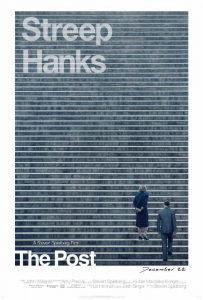
Despite its shortcomings, however, “The Post” has been extensively honored in this year’s award competitions, most recently with two Oscar nominations for best picture and actress (Streep). The film also captured three National Board of Review awards for best picture, actress (Streep) and actor (Hanks) and was named American Film Institute Movie of the Year. In addition, the picture earned six Golden Globe nominations (best dramatic picture, director, screenplay, score, dramatic actor, dramatic actress) and eight Critics Choice Award nods (best picture, director, original screenplay, score, editing, acting ensemble, actor, actress), though it took home no statues in either of these competitions.
Taking a stand is truly a noble act – but one that’s often fraught with great risk (and rewards). When up against such circumstances, we must weigh what’s at stake and the consequences of what each outcome might bring. Should we emerge victorious, however, we can look back and see just how meaningful our efforts prove to be.
Copyright © 2018, by Brent Marchant. All rights reserved.
The post ‘The Post’ examines what it takes to do the right thing appeared first on Brent Marchant.
January 24, 2018
This Week in Movies with Meaning
Reviews of “The Post,” “Molly’s Game” and “Film Stars Don’t Die in Liverpool” are all in the latest Movies with Meaning post on the web site of The Good Media Network, available by clicking here.


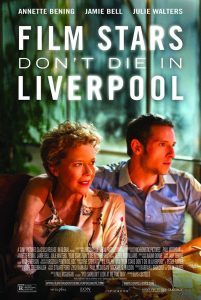

The post This Week in Movies with Meaning appeared first on Brent Marchant.
January 23, 2018
Tune in for The Cinema Scribe
Tune in for the latest Cinema Scribe segment on Bring Me 2 Life Radio, Wednesday, January 24, at 12:45 pm ET, by clicking here. And, if you don’t hear it live, catch it later on the podcast!

The post Tune in for The Cinema Scribe appeared first on Brent Marchant.
Tune in for the Bring Me 2 Life Podcast!
Join host Selo Closson and yours truly for a special episode of the Bring Me 2 Life radio podcast, premiering today, January 23, by clicking here. We’ll discuss my new book, Third Real: Conscious Creation Goes Back to the Movies, as well as how films (including current releases) reflect conscious creation/law of attraction principles. And tune in starting January 30 for the official launch of Season 5 of the Bring Me 2 Life podcast!


The post Tune in for the Bring Me 2 Life Podcast! appeared first on Brent Marchant.
January 16, 2018
This Week on The Cinema Scribe
Tune in for the latest Cinema Scribe segment on Bring Me 2 Life Radio, Wednesday, January 17, at 12:45 pm ET, by clicking here. And, if you don’t hear it live, catch it later on the podcast!

The post This Week on The Cinema Scribe appeared first on Brent Marchant.
This Week in Movies with Meaning
A Review of “I, Tonya,” a video preview, and a look at 2017’s best and worst movies are all in the latest Movies with Meaning post on the web site of The Good Media Network, available by clicking here.



The post This Week in Movies with Meaning appeared first on Brent Marchant.
January 14, 2018
The Best and Worst of 2017
Another year in filmdom has come and gone, and countless movie reviewers have issued their best and worst lists for 2017. And so, with that said, it’s time to add my voice to the chorus, with my choices for the cream of the crop and the curdled cream best discarded.
In the interest of full disclosure, I must confess that I did not screen every film that was released in 2017, most notably those that were distributed through limited or select channels, such as the Netflix exclusive “Mudbound.” However, I did spend considerable time staring at those flickering lights on the big screen last year, enough to make me feel comfortable in offering up my selections for the pictures that I believe represented the best and worst of past 12 months.
As always, I’d love to hear your feedback in the comments section (be civil, please). And with that, here goes:
THE TOP 10
10. “Get Out”
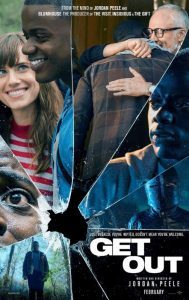
Despite some occasional pacing issues during the first hour, this satirical sci-fi thriller – often described as “Guess Who’s Coming to Dinner?” meets “The Stepford Wives” – delivers hefty laughs, ample suspense and biting social commentary that might make even the most self-avowed open-minded viewers squirm. Writer-director Jordan Peele hits a home run in his debut feature, making a mark that one can only hope is a sign of things to come. Those who enjoy thought-provoking cinema with unexpected plot twists are sure to like just about everything this release has to offer.
9. “Logan Noir”
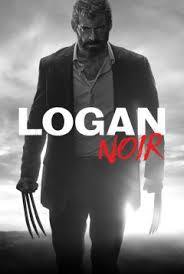
What a difference cinematography can make! This is the version of “Logan” that should have been released in the first place. As good as the full-color edition is, the noir version’s stunning black-and-white cinematography takes an entertaining bubble gum action-adventure and effectively elevates it to the level of a serious screen drama. The atmospheric filming style makes the landscape shots positively gorgeous and adds dimension to the performances of Hugh Jackman, Patrick Stewart and Dafne Keen, taking them beyond stars in a superhero movie and making them actors in a film worthy of note. It also magnifies the epic quality of this story within the context of the Wolverine franchise, quite an accomplishment achieved with such a simple technological change. Admittedly, the film still drags a bit in the middle, and some of the violence borders on being a tad gratuitous. But, these shortcomings aside, “Logan Noir” is truly a film worth seeing, not only for action-adventure fans, but also for cinema lovers of all stripes.
8. “Ingrid Goes West”
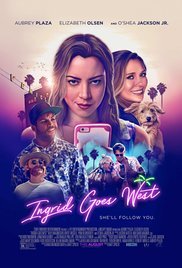
A scathingly devastating dressing down of social media culture and our vapid obsession with today’s undeservedly overrated adult iteration of “the popular kids.” Aubrey Plaza delivers a solid, award-worthy performance in the title character’s role, backed by a strong cast of supporting players who execute their portrayals with precision and incisive accuracy. Those who easily see through the thin veneer of what’s supposedly laudable these days will readily detect the unfortunate shallowness of many of our collective ways wickedly brought to life in this impressive debut feature from director Matt Spicer. Let’s hope the message sinks in, especially amongst those most in need of getting it.
7. “Dunkirk”

How refreshing it is to see a big-budget action-adventure film that truly lives up to all of its pre-release hype. This expertly made World War II saga presents a stirring account of this epic historic event, with a superb, ever-suspenseful narrative that’s backed up by masterful cinematography, editing, special effects and sound technology, as well as an edgy, skillfully applied original score. What’s more, unlike many other war movies, this offering effectively depicts man at both his worst and his best in the same film, quite an accomplishment to be sure. Director Christopher Nolan has clearly knocked it out of the park with this one.
6. “Last Flag Flying”

A truly moving cinematic experience that’s not to be missed. With a rollercoaster of emotions and an intriguing road trip narrative, the film takes viewers through an array of feelings and moods from tremendous hilarity to profound sadness, and nearly always seamlessly. Most of all, however, this latest offering from director Richard Linklater features three of the strongest male lead performances to come along in quite a while (kudos to the casting director for skillfully choosing Steve Carell, Bryan Cranston and Laurence Fishburne for their remarkable portrayals and their undeniable chemistry). Admittedly, the picture gets off track a few times, going on several needless tangents, but overall this strong, solid film is well worth one’s time. It’s truly unfortunate that this release has been noticeably, if not deliberately, ignored for awards consideration.
5. “Columbus”
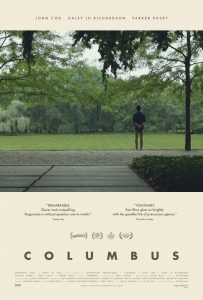
A nearly perfect film in virtually every regard, this quiet, cerebral meditation about life, loving, healing, forgiveness, personal growth and human relations gives viewers much to think about, especially when faced with hard choices. Set against the beautiful backdrop of architectural mecca Columbus, Indiana, the film’s exquisite, Kubrick-esque cinematography, ethereal, haunting score, and deft use of sound provide elegant wrapping for this sometimes-humorous, sometimes-heartbreaking, frequently mesmerizing tale. Don’t expect much action from this one; in fact, don’t be surprised if you often find yourself wondering where the story is going, given its often-cryptic dialogue. But sit back, let the film wash over you and take it all in – you’ll likely be very pleasantly surprised, especially by the outstanding performance of John Cho, who demonstrates talents not seen in any of his previous roles. A quiet masterpiece.
4. “Brigsby Bear”
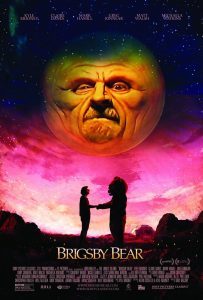
One of the most creative, thoughtfully written comedy-dramas in recent years. Its quirky but touching narrative, superb script and fine performances make this offbeat, description-defying release a captivating piece of filmmaking from start to finish. And, the closer you pay attention to this one, the more you’ll see, a truly gratifying moviegoing experience. Hooray for Brigsby!
3. “The Shape of Water”

Though at times a little formulaic, this inventive fantasy/fairy tale delivers the goods with superb special effects, gentle humor, heartwarming sincerity, and a host of excellent performances, especially by Sally Hawkins, Octavia Spencer and Richard Jenkins. Think “Beauty and the Beast” meets “E.T.,” and you’ve got a good idea what’s going on here. This one may strike a few odd chords, but it nearly always does so in perfect pitch.
2. “Three Billboards Outside Ebbing, Missouri”
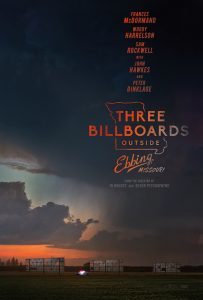
This dark comedy-drama, with its ample, in-your-face gallows humor and unrelenting colorful vulgarity, takes big chances on its way to easily becoming one of the best releases of 2017. With stellar performances by Frances McDormand, Woody Harrelson and Sam Rockwell, the picture keeps us guessing, even when we think we’ve figured things out, using assorted misdirections to captivate viewers throughout. Despite a slight tendency to drag in the second half, the film overall is a flat-out winner, though definitely not something for the sensitive or squeamish.
1. “I, Tonya”

Handily the year’s best, with its wickedly macabre humor and superb performances across the board, especially Margot Robbie and Allison Janney in positively stellar performances. With a kick-ass soundtrack, impeccable editing, excellent writing and a spot-on monologue format, this cynical, fact-based biopic carries the day in virtually every regard. To be sure, sensitive viewers may be offended by some of the language and violence, but both are properly balanced and in context. If you like your comedies with an edge, rush to see this one.
HONORABLE MENTIONS (IN NO PARTICULAR ORDER)
“The Big Sick”
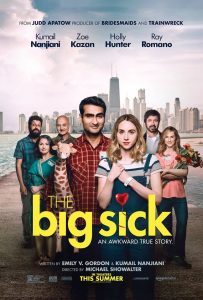
A charming yet edgy romantic comedy that breathes new life into a genre that has grown progressively tiresome and stale. Based on the protagonist’s own unusual courtship experience, the film takes chances that movies of this ilk are seldom willing to do. Despite a slight tendency to drag a bit in the final 30 minutes, this fresh, lively offering features fine performances all around (especially by Holly Hunter and Ray Romano in strong supporting roles) and raucously funny bits not typical of rom-coms. See this one – you won’t regret it.
“Lucky”

Though sometimes a little too cryptic for its own good, this otherwise-reflective meditation on life, existence, mortality and human relations provides viewers with much to ponder about the state of one’s reality and how it’s shaped. With an excellent, career-topping performance by the late Harry Dean Stanton, coupled with a strong supporting ensemble, this quiet, low-key debut feature from actor-director John Carroll Lynch explores the meaning of life and the secrets to help make it fulfilling, both while we’re here and as we’re about to make our ultimate transition. A promising first effort from a filmmaking newcomer and the crowning achievement of a veteran performer’s repertoire.
“Battle of the Sexes”
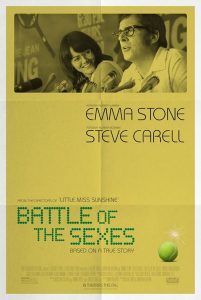
A well-crafted time capsule offering that superbly re-creates one of the biggest sports and social spectacles in recent history. With excellent performances by Emma Stone and Steve Carell – who practically channel the essence of their characters – and masterful period piece production values, this entertaining offering effectively captures the look and feel of its subject matter and its place in modern American cultural history. Admittedly, the picture tends to drag slightly in the first 45 minutes, but, this shortcoming aside, the film otherwise delivers in every other regard. Game, set, match.
“Marjorie Prime”

A thoughtful, insightful look at coping with grief, promoting healing, reconciling interpersonal discord, preserving memory, growing comfortable with technology, assessing the nature of reality and contemplating the fate of human evolution, all wrapped up in an intimate, beautifully filmed, well-acted, smartly conceived sci-fi offering. Although the script at times doesn’t quite rise up to the level of its narrative and Pulitzer Prize-nominated source material, the film nevertheless touches many bases and gives viewers much to contemplate. With an excellent ensemble cast, highlighted by a superb performance by long-underappreciated character actress Lois Smith, this latest production from director Michael Almereyda once again distinguishes the filmmaker as one of today’s most inventive, ambitious and underrated talents in the business. “Marjorie Prime” may be a little difficult to find, but it’s well worth the search.
“The Journey”

What it lacks in authenticity is more than made up for by its fictional though thoughtful debates of the issues at the heart of the Northern Ireland peace process, why it took so long to resolve and the remarkable steps it required to bring about a workable solution. Add to that the sizzling performances of Timothy Spall and Colm Meaney, and you’ve got a riveting series of dialogues that, in lesser hands, might easily have come off as a dry, plodding history lesson. While I usually have issues with films that take such blatant dramatic license, and even though the writing and narrative occasionally go wildly off the rails, this inventive take on this subject matter satisfies immensely without ever becoming tedious or pretentious. There’s much more here than what many of the dismissive accounts contend, and it involves material worth watching – and perhaps applying when circumstances merit.
“Beatriz at Dinner”
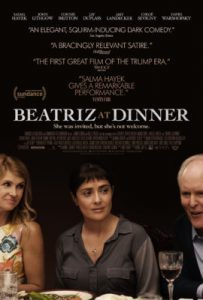
At times brilliant, at times frustrating, this dark, sociopolitical satire gives viewers much to ponder both practically and metaphysically, a rare fusion for a film these days. It also manages to maintain a fair amount of suspense at an event – a dinner party – that would seem an unlikely setting for such a narrative quality. Salma Hayek gives one of the year’s best performances, more than adequately backed by a superb ensemble of supporting players, most notably John Lithgow. Admittedly, it’s a little disappointing that the film draws upon a concluding plot device that’s been used before (even if it’s employed in a way not seen before), but, this disappointment aside, “Beatriz at Dinner” gives us much to think about at a critical juncture in our country’s – and our reality’s – history.
“The Post”

After a painfully slow start, “The Post” thankfully finds its legs about 40 minutes in, at last taking off on a more engaging pace as it moves toward an inspiring (albeit predictably feel good) conclusion. It’s a film with a timely (though, one can’t help but cynically wonder, regrettably tardy) message about the state of journalism in an America presently besieged by corporate media consolidation and heavy-handed attempts to quash free speech. Meryl Streep and Tom Hanks turn in adequate performances in their lead roles (though definitely far from their best), with the real stars shining in the supporting parts (particularly Bob Odenkirk, Bruce Greenwood and Matthew Rhys). Given the current political climate, “The Post” is the right film with the right message that liberal Hollywood adores and loves to lavish with honors. It’s just too bad that it’s not a better picture.
“Film Stars Don’t Die in Liverpool”

A vastly underrated gem that definitely deserves wider attention – and more recognition – than it has received thus far. With what is arguably Annette Bening’s best screen performance, coupled with a fine counterpart lead portrayal by Jamie Bell and an emotive closing song by Elvis Costello, this heartfelt romantic tearjerker justifiably earns every bit of emotion it evokes from audiences. Don’t listen to the cynics; if you enjoy good old-fashioned love stories, go see this one, but keep the tissues handy.
“The Hero”
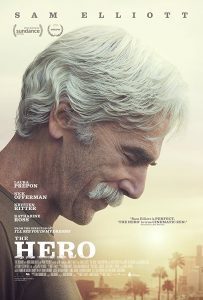
A quiet but powerful character study about an aging Western movie actor full of regrets seeking to make amends with whatever time he has left. Featuring a solid performance by Sam Elliott in a rare leading role, the film touches the heart without ever becoming maudlin, sappy or manipulative. A genuine surprise worthy of one’s time.
BOTTOM 10
10. “Paris Can Wait”

Though beautifully filmed, this journey through the French countryside can never really make up its mind if it wants to be a travelogue or a romantic escapade. Short on character development and interpersonal chemistry but long on lusciously photographed examples of French cuisine, the story meanders through a largely unconvincing narrative toward a predictable and unsatisfying ambiguous conclusion. This ground has been covered in a number of other prior offerings – and better. Clearly, this is one on which we can all wait.
9. “Wonder Wheel”
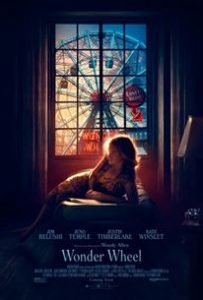
While stunning visually, this latest offering from filmmaker Woody Allen has to rank among the worst of his offerings. With leads who are horribly miscast (especially Kate Winslet in a bombastic exercise of overacting), writing that’s seriously bloated and in need of retooling, and characters who are neither likable nor believable, the film tells a tale that in many ways feels like a working class 1950s retread of “Blue Jasmine” with elements of “Café Society” thrown in. As much of a fan as I am of the director’s work, I whole-heartedly recommend skipping this one – and hope that he gets back on track with his next project.
8. “The Beguiled”

While atmospherically on target, this tedious slog never engages, leaving viewers waiting for an ending that takes far too long to come, even in spite of its scant 94-minute runtime. Half-baked performances that could have been phoned in, underscored by virtually nonexistent Southern accents, make for a cast of confederate belles who look bored, disinterested, even robotic at times. The sinister, macabre suspense depicted in the film’s preview makes the picture appear more captivating than it is, a genuine disappointment to be sure. Watch the trailer instead of the theatrical release for this one, and you’ll see a better, if shorter, movie.
7. “Alien: Covenant”

This is a franchise sorely in need of something radically fresh to keep it alive or a cancellation notice to put it (and viewers) out of misery. With the exception of a few spiritual vs. scientific plot devices, there’s essentially nothing new here that we haven’t already seen many (and I do mean many) times before. Any attempts at enlivening the narrative are derivative at best, shedding no particularly new light on why any of this matters (or why viewers should care). Go back and watch the first two movies in the series – they’re much better.
6. “Valerian and the City of a Thousand Planets”

Simply put, a big, fat, incredibly overlong snooze. This poorly written, frequently trite and shamelessly derivative alleged action-adventure saga sapped most of my interest about 20 minutes into its nearly 2.5-hour runtime. To make matters worse, this needlessly episodic trial of viewer patience features abysmal casting (save for a few supporting players irretrievably trapped in their thankless roles), special effects that seem to exist largely for their own sake and a woefully inadequate back story that cripples the picture almost from the outset. Avoid this one if you possibly can.
5. “Mother!”
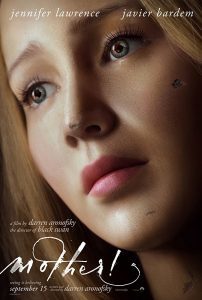
Pretentious! Obvious! Crap! There – I said it flat out, with the same kind of in-your-face, virtually nonstop barrage of gratuitous imagery that makes up much of the content of this over-the-top exercise in cinematic self-indulgence. Despite several fine performances (particularly Michelle Pfeiffer) and an inventive production design, these assets can’t save this morass of self-evident religious cliché mixed with contemporary social commentary. See this one at your peril lest you come away from it saying “There’s two hours of my life I’ll never get back.”
4. “The Killing of a Sacred Deer”

When making a psychological thriller, the cardinal rule is not to make it boring, but, unfortunately, this dull, unintelligible offering falls into that trap within the first 10 minutes. A stilted script, wooden performances and undecipherable narrative drive this cinematic mess into the ground quickly. It’s truly disappointing that the creator of “The Lobster” followed up that brilliant work with this self-indulgent garbage. It’s one thing for a film to be off-beat and unconventional, but it’s something else entirely to be so muddled that it’s impossible to figure out what’s going on. Oh, and by the way, Colin Farrell and Nicole Kidman – given that you’ve each got two films in my Bottom 10, please start picking your scripts better.
3. “Life”

“Derivative,” it seems, is not just a financial term – it’s also an apt way of describing this flat, unoriginal, overlong, poorly written knock-off of “Alien” with homages to “Gravity” and “Armageddon” thrown in for good measure. The story is wholly predictable in virtually every regard, right down to its supposed final plot twist. Some of the special effects are genuinely well done, but some others are positively silly. It’s easy to see how this one got moved out of the summer blockbuster release season; it would have been easily embarrassed by its competition. The film’s tag line says “We were better off alone”; that really should read “We were better off staying home.”
2. “The Circle”
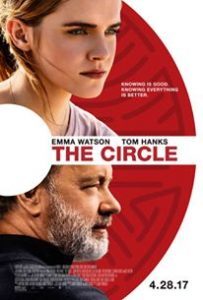
Is it a thriller? A satire? Both? Neither? It’s hard to tell, since the filmmakers obviously didn’t know what they were doing or trying to achieve. This overwrought, unfocused mess can’t decide what it wants to be. Despite a decent performance by Tom Hanks and an attempt to address issues of social relevance (halfhearted though that effort may be), the picture’s largely preposterous story line, monodimensional character development, and abysmal performances by Emma Watson and (especially) Ellar Coltrane sink this one rather quickly, leaving viewers longing for the ending far ahead of its arrival. Handily one of the biggest disappointments of the year.
1. “Split”

A positively awful movie and a sad cinematic commentary on the career of a director who was once one of Hollywood’s shiny rising stars. Despite James McAvoy’s admirable attempt at putting lipstick on this celluloid pig, as well as some allegedly lofty efforts at trying to elevate the tone of the narrative above its simplistic, unsettling nature, there’s nothing here to make this glorified slasher picture memorable, insightful or, at times, watchable. Keep those hard-earned dollars in your wallet.
DISHONORABLE MENTIONS (IN NO PARTICULAR ORDER)
“Wonderstruck”
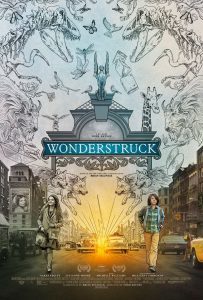
When one watches a film with the word “Wonder” in the title, one expects it to evoke feelings in line with that term. However, this drawn-out, sleepy mess never lives up to its billing, leaving viewers constantly hankering for the story to “get on with it already.” A true waste of talent, cinematic resources and viewers’ time.
“The Wedding Plan”
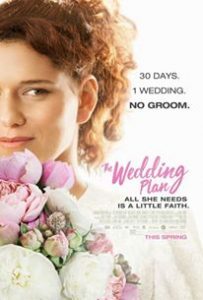
What starts out as a modestly funny premise begins falling apart about midway through by lapsing into a series of prolonged, talky conversations that lack even moderate laughs and harp on belabored spiritual and philosophical musings. It’s unfortunate that the filmmakers didn’t tap into the deep veins of humorous potential here, instead choosing to serve up something far less substantial than it could have been. Send your regrets, and skip this one.
“Ghost in the Shell”

It’s unfortunate when the substance of a good story gets buried under layers of cinematic style, keeping the essence of the underlying narrative from shining through. But that’s precisely the problem with this live action anime feature. An over-reliance on action sequences and stunning (but decidedly excessive) visual effects dilutes the relevance and poignancy of this film, depriving viewers of the most important attribute it has to impart. Scarlett Johansson’s staid, detached bad-ass routine is growing a little stale, too, a virtual carbon copy of the performances she gave in “Lucy” and “Under the Skin.” And then there’s the movie’s tendency to borrow from numerous other sources, like “Blade Runner,” “The Matrix,” “Cloud Atlas,” “Ex Machina” and “Total Recall,” to name a few. Pass on this one – you won’t miss much.
“Call Me By Your Name”
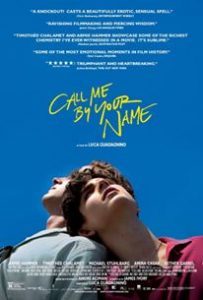
Though beautifully filmed and scored, with generally capable performances, this overrated, tiresome, trite exercise in tedium disappoints overall. With a script characterized by bloated, stilted, implausible dialogue and a narrative that’s been done countless times before, there’s precious little about this annoying slog that we haven’t already seen many, many times previously. Save for one particularly touching scene toward the film’s close that helps to redeem much of what precedes it, “Call Me By Your Name” fails to live up to its potential – or its press releases.
“Phantom Thread”
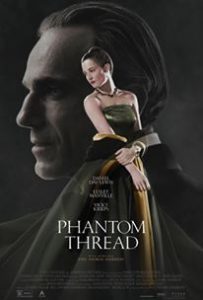
Despite exquisite costume design, some occasionally humorous moments, and fine performances by Daniel Day-Lewis and Lesley Manville, this exercise in pretentious self-indulgence passing itself off as audacious art is cold, unengaging and implausible virtually from the outset. This bizarre fusion of “Fifty Shades of Grey,” “The Devil Wears Prada” and “The Beguiled” never gels and leaves viewers wholly unsatisfied by the end of its overlong runtime. It’s unfortunate that Day-Lewis chose this vehicle as the performance to cap off his otherwise-brilliant career.
Copyright © 2017-18, by Brent Marchant. All rights reserved.
The post The Best and Worst of 2017 appeared first on Brent Marchant.
January 3, 2018
‘I, Tonya’ reveals the dual-edged sword of ambition
“I, Tonya” (2017). Cast: Margot Robbie, Sebastian Stan, Allison Janney, Paul Walter Hauser, Bobby Cannavale, Julianne Nicholson, Bojana Novakovic, Caitlin Carver, Mckenna Grace, Jason Davis, Ricky Russert, Anthony Reynolds, Lynne Ashe, Dan Triandiflou, Jan Harrelson, Luray Cooper, Maizie Smith. Director: Craig Gillespie. Screenplay: Steven Rogers. Web site. Trailer.
Being the best at what we do is something to which many of us aspire. With great heart, tremendous determination, a plucky attitude and our own brand of innovation, we forge ahead as we strive to surmount that pinnacle of success. But is it possible for those efforts to be excessive or get out of hand? Under conditions like that, our aims may become skewed, perhaps even turning counterproductive, no matter how ardent our passion or how steely our resolve. Such is the case in the new, fact-based dark comedy, “I, Tonya.”
Told largely through a skillfully edited mix of insightful monologues and revelatory flashbacks, the film tells the often-comic, satirically tragic biography of figure skater Tonya Harding (Margot Robbie), who attained a number of accomplishments on the ice but is perhaps best known for an explosive off-rink scandal that fueled tabloid headlines for months.

The ups and downs of figure skater Tonya Harding (Margot Robbie) spin a compelling story as detailed in the new, fact-based biopic, “I, Tonya.” Photo courtesy of Neon and 30West.
Beginning in childhood, the picture follows the life of a young Tonya (Maizie Smith, Mckenna Grace) as she hones her talents under the skillful training of coach Diane Rawlinson (Julianne Nicholson). But, in stark contrast to the artistry Tonya was developing on the ice, the emerging star also had to contend with the harsh conditions of her home life, circumstances characterized by financial strife and incessant physical and verbal abuse. She was constantly under the thumb of her beastly, controlling mother, LaVona (Allison Janney), a snarly, foul-mouthed, embittered waitress who routinely pummeled and chastised Tonya for the slightest of infractions when not embroiled in expletive-laden quarrels with her husband (Jason Davis).
Given her hard life off the ice, Tonya developed a somewhat thick skin and something of an edge, qualities that became reflected in her skating. While many of Tonya’s peers aspired to live up to the stereotypical ultra-feminine attributes long associated with the sport, she developed her own style, one characterized by skating programs set to heavy metal music and costuming punctuated by blue nail polish. She also exhibited a greater athleticism than many of her competitors. But, while these innovations set her apart, they failed to impress competition judges, most of whom were looking for a more traditional presentation, one characterized by more conventional (i.e., more demure) qualities. Such displeasure was reflected in the scores Tonya earned in competition (despite the technical strength of her performances), which, in turn, would invariably bring out LaVona’s wrath, generally prompting severe verbal onslaughts (if not more).
To cope, Tonya sought out the company of those whom she hoped would treat her decently, such as her boyfriend, Jeff Gillooly (Sebastian Stan), a handsome if somewhat doltish sort who claimed to adore her but ultimately engaged in abusive behavior equal to that of LaVona. Still, despite such shoddy treatment, Tonya took refuge in Jeff’s home when life with her mother became unbearable, a move that was tantamount to jumping from the frying pan into the proverbial fire.

Jeff Gillooly (Sebastian Stan, right), husband of figure skater Tonya Harding, concocts a scheme to advance her career with her doltish bodyguard, Shawn Eckhardt (Paul Walter Hauser, left), in the new dark comedy, “I, Tonya.” Photo courtesy of Neon and 30West.
Meanwhile, on the ice, Tonya sought to find new ways to distinguish herself, a move aimed at leveling the playing field and silencing the small-minded critics who claimed she didn’t play the princess role well enough. She decided to make an attempt at being the first woman to land a triple axel jump in competition, an exceedingly difficult program element involving three-and-a-half revolutions. If she were to perform it successfully, that would surely make her a stand-out – and shut up the naysayers – an accomplishment attained at the 1991 U.S. Figure Skating Championship, where Tonya emerged the winner.
With her grand achievement behind her, Tonya suddenly became skating’s “it” girl, despite her less-than-conventional style. She was now being touted as a hot contender for the 1992 Olympics in Albertville, France. But, given a disappointing performance at the Winter Games and too many domestic distractions off the ice, she seemed to have missed her chance. This, coupled with allowing herself to fall out of shape, she quickly seemed to become a skating has-been at the age of 21. However, with a shortened two-year time frame before the next Olympics in Lillehammer, Norway and the encouragement of coach Rawlinson, Tonya was talked into making a run at the 1994 Winter Games.
There was just one problem: Tonya would have to contend with the competition posed by skater Nancy Kerrigan (Caitlin Carver), whose star was quickly rising after earning a bronze medal at the Albertville Games. Ironically, the two were actually fast friends, but, when it came to competition, those bonds would vanish, with relations between them becoming strained. And, in the months ahead, Tonya would find that “strain” wouldn’t even begin to describe what was about to go down.

LaVona Golden (Allison Janney), the beastly, overbearing mother of figure skater Tonya Harding, seeks to control every aspect of her daughter’s life in the dark new biopic, “I, Tonya.” Photo courtesy of Neon and 30West.
What happened next stunned the skating community and the world at large when Kerrigan was brutally attacked after finishing practice before the U.S. nationals in Detroit. An assailant surprised her off the ice, clubbing her with a baton just above the knee. That assailant would turn out to be Shane Stant (Ricky Russert), an attacker hired by Gillooly and Shawn Eckhardt (Paul Walter Hauser), Tonya’s inept, dimwitted bodyguard, who delusionally fancied himself a covert spy master and intelligence operative. The plan called for Stant to break Kerrigan’s leg to keep her from competing in Lillehammer, but, as events played out, she suffered only a severe bruise, one that would heal up in time for the Winter Games.
With Kerrigan sidelined, Harding won the U.S. Championship and a spot on the Olympic squad. However, despite this victory, her star was tainted as rumors began to circulate. Even though Tonya claimed to have no knowledge of the scheme, the event nevertheless stuck to her like glue thanks to guilt by association, quickly leading to the launch of an FBI investigation. And the firestorm set off by the attack and its fallout would occupy headlines for a long time afterward, with consequences that followed the fallen star for years after stepping off the ice.
Almost no one would criticize someone for having ambition, but, when such drive turns a blind eye to everything that could potentially accompany it, we run the risk of setting ourselves up for major trouble. Such supremely singularly focused aspirations, like anything else that materializes in our lives, are a product of our thoughts, beliefs and intents, the cornerstones of the conscious creation process, the means that makes these manifestations possible. And, in true conscious creation fashion, those materializations always arise from those fundamental building blocks, no matter what they may be – warts and all.
In Tonya’s case, it’s easy to make the case that her ambition beliefs were tinged by intents aimed at succeeding at almost any cost. Given her troubled upbringing, marriage and competition experience, Harding’s desire for recognition and acceptance could well have been a powerful motivation, adding fuel to the skater’s drive for success. But that belief mix can easily become a volatile combination, particularly if one pays no heed to the potential fallout, especially if that involves turning a blind eye to the efforts of others supposedly acting on our behalf.

Figure skating coach Diane Rawlinson (Julianne Nicholson, left) watches her star pupil, Tonya Harding, during one of her performances in the compelling new biopic, “I, Tonya.” Photo courtesy of Neon and 30West.
While it’s entirely possible that Harding never heard of conscious creation, it’s apparent from her successes that she nevertheless had developed a certain mastery over its principles. However, given how other events unfolded, it’s also apparent that she could fall victim to the process of un-conscious creation or creation by default, whereby we become so obsessed with achieving our objectives that we may disregard the consequences associated with them, especially if we give them no attention.
Of course, if Tonya’s drive for recognition and acceptance was an outgrowth of her background, one might wonder why she drew those circumstances into her life in the first place, especially since conscious creation makes an infinite range of options available to us at any given moment. That’s a legitimate contention, but, as any seasoned conscious creator knows, the conditions we manifest for ourselves are rooted in our own reasons, usually based on our need to tackle specific life lessons. How we address those lessons is part of our ongoing personal growth and development, and we again have limitless options for response to them, some of which may turn out more successfully than others. Tonya’s responses naturally reflect the beliefs she held at the time, which, like those of any conscious creator, are thought to be the wisest course to follow at the moment.
Had the underlying beliefs been different, the outcomes would have obviously been different, too. But, circumstances being what they were (i.e., given what had been created in the first place), results arose in line with the beliefs at play in this scenario. That being the case, then, Tonya’s experience provides audiences with a strong cautionary tale about how to wield our personal power of creation. Treading carefully would indeed appear to be in order.

Handily one of the year’s best, “I, Tonya” seethes with its richly macabre humor, which relentlessly comes at viewers in a variety of forms, be it through the characters’ monologues, the actions taking place on screen or the players’ snarky asides delivered directly to the audience in the midst of the mayhem playing out around them. The film features superb performances across the board, especially Robbie and Janney in award-worthy performances. With a kick-ass soundtrack, impeccable editing, excellent writing and a spot-on narrative, the film carries the day in virtually every regard. To be sure, sensitive viewers may be offended by some of the language and violence, but both are properly balanced and in context. If you like your comedies with an edge, rush to see this one.
“I, Tonya” has been deservedly rewarded in this year’s awards competitions, picking up three Golden Globe nods (best comedy picture, actress, supporting actress), five Critics Choice Award nominations (actress, supporting actress, comedy, actress in a comedy, hair./makeup), two Screen Actors Guild Award nods (Robbie, Janney) and three Independent Spirit Award nominations (actress, supporting actress, editing), with more honors likely to come. I’d be thrilled to see this offering take home a lot of this hardware, as it’s a release truly worthy of it.
Aiming for the stars is undoubtedly a laudable goal, one that can help us see – and realize – our potential. But, in the process, we need to keep our eyes open during the course of our ascent, looking around us to determine that we’re on the right path and don’t draw undue problems to us along the way. Should we do so, we’re likely to nab our own gold medals as a result, honors that we genuinely earn – and needn’t worry about ever becoming tarnished.
Copyright © 2017-18, by Brent Marchant. All rights reserved.
The post ‘I, Tonya’ reveals the dual-edged sword of ambition appeared first on Brent Marchant.
December 28, 2017
‘Darkest Hour’ inspires us to rise to our own greatness
“Darkest Hour” (2017). Cast: Gary Oldman, Kristin Scott Thomas, Ben Mendelsohn, Stephen Dillane, Samuel West, Lily James, Ronald Pickup. Director: Joe Wright. Screenplay: Anthony McCarten. Web site. Trailer.
Sometimes it takes having our backs against the wall to realize the greatness of which we’re truly capable. Getting there may seem like a dire process, and we may be ready to break down or give it all up if hope appears lost. Such dark night of the soul moments test us to the limit but also show us exactly what we’re made of, a scenario pointedly depicted in the new, fact-based historical drama, “Darkest Hour.”
At the outset of World War II, the British government sought to minimize its involvement and the potential for bloodshed by practicing a policy of appeasement put forth by Prime Minister Neville Chamberlain (Ronald Pickup). By bending to the demands of German Chancellor Adolf Hitler, the U.K. hoped it could curtail the rising tide of warfare. However, when it became apparent the Fűhrer had no intention of honoring his agreements, the need for a new strategy – and a new British P.M. – became all too clear.
But, British politics being what they were at the time, there was also a need to establish a coalition government, one that ultimately was headed by an unlikely leader – Winston Churchill (Gary Oldman), an aging statesman in whom many politicians and even the Crown had little confidence. His track record of past failures haunted him, and many saw him as a buffoon and a catastrophe waiting to happen. Nevertheless, despite these issues, Churchill managed to rise to the top and was asked to form a government by King George VI (Ben Mendelsohn), albeit quite reluctantly.

British Prime Minister Winston Churchill (Gary Oldman) assumes the reins of power at one of the most critical junctures in the nation’s history as depicted in the new, fact-based historical drama, “Darkest Hour.” Photo by Jack English, courtesy of Focus Features.
Once Churchill assumed the reins, he was quickly faced by a severe wartime crisis – the surrounding of British forces by German troops at the French seaport of Dunkirk. With virtually the entire British military in serious peril and the Germans overrunning Europe with no opposition, Churchill faced the collapse of Allied forces and a potential massacre of its own trapped troops. He was thus thrust into devising a plan – any plan – to stave off these twin tragedies.
At the same time, Churchill was being pressured by his own War Cabinet to enter into peace talks with the Germans, to be brokered by Hitler’s Italian allies. This option, advanced by Churchill’s political rivals, most notably Viscount Halifax (Stephen Dillane), would theoretically end the carnage but would essentially turn the U.K. into a fascist lap dog. Conversely, it was believed that rejection of this initiative would ensure British failure in dealing with the crisis on the French coast. And, the more this scenario was allowed to play out, the more Churchill was being railroaded into a position of being labeled a collaborator or an incompetent, either of which would provide grounds for his ouster.
Churchill didn’t always help his own case, either. He was known for his prolific, unabashed imbibing, and he frequently spoke his mind, even when candor wasn’t called for. He even shocked many would-be supporters with his famous (or some would say infamous) “V for Victory” hand gesture, which, in some segments of society, was taken to mean something entirely different (and not especially socially acceptable). However, this unrestrained, freewheeling approach to life also gave him a strong sense of self-confidence, one that would prove to be a saving grace.

At the request (albeit reluctantly) of King George VI (Ben Mendelsohn, right), British Prime Minister Winston Churchill (Gary Oldman, left) is invited to form a new government at the start of World War II, events outlined in the new historical drama, “Darkest Hour.” Photo by Jack English, courtesy of Focus Features.
No matter what he was up against, Churchill staunchly believed that Britain had to remain firm in its resolve, convinced that the fate of Western civilization was at stake. However, given the pressures he faced, he was also on the verge of cracking. To be sure, he had devoted supporters in his corner, such as his beloved wife Clementine (Kristin Scott Thomas) and loyal secretary Elizabeth Layton (Lily James), but, in seeking solutions to his challenges, he was virtually alone. If he were to survive this crisis, he would have to get creative, both in coming up with plans of action and winning over supporters, which, in each case, would prove to be the people who would come to help him most – the British citizenry.
Churchill’s amazing saga at the start of World War II is a prime example of someone rising to his own greatness, exceeding his potential at a time when the odds were overwhelmingly stacked against him. This inspiring tale shows what we’re each capable of, even in the face of seemingly insurmountable challenges. It shows what it means to surpass everything we thought we could do – and thrive in the process. And that success is largely attributable to the conscious creation process, the means by which we manifest the reality we experience through the power of our thoughts, beliefs and intents.
It’s a pretty safe bet that Churchill probably never heard of conscious creation, yet, based on his actions as depicted in this film, it’s apparent he was quite adept in wielding it. For instance, to solve the problems he faced, he was forced into getting creative, thinking outside the box, pushing limitations, conceiving inventive plans and coming up with manifestation beliefs that had never been tried or perhaps even thought of. This became obvious in his solution for evacuating British troops from Dunkirk when they were penned in by the Germans. Because Britain’s large military rescue ships were unable to land at the French port because of relentless enemy air cover that made them sitting ducks, Churchill had to devise a workable alternative to effect the evacuation. His solution was to put out a call for a citizen armada, a plea to British citizens to deploy their own vessels – fishing boats, pleasure craft, etc. – in a ragtag but concerted effort to bring the boys home. It was a plan no one saw coming – including the Germans – and it had a huge impact on the country’s ability to remain viable in a conflict in which it was becoming increasingly involved.

With the support of his loving wife Clementine (Kristin Scott Thomas, left), British Prime Minister Winston Churchill (Gary Oldman, right) assumes the reins of power during a difficult time in the nation’s history in director Joe Wright’s latest offering, “Darkest Hour.” Photo by Jack English, courtesy of Focus Features.
Such creativity was essential for Churchill to maintain his political stance as well. With the opposition breathing down his neck and with lukewarm support from the Crown, there were many times when the P.M. felt completely alone. To counter these measures, he needed to win over supporters to ensure his continuation in office, namely, the British public and wavering members of Parliament. Through his stunning oratory, impassioned pleas and interaction with the citizenry – acts that he had not previously engaged in or was especially proficient at – he made a case for his beliefs, which subsequently turned into manifested results, particularly when it came to rallying others behind his cause.
To make these plans work, though, Churchill also had to draw upon several key conscious creation principles. For example, he had to overcome any fears or apprehensions he might have had, something that seldom tripped him up but that became progressively more arduous as the pressure placed on him from multiple fronts continued to mount. He had to be willing to take bold moves, particularly when it came to speaking his mind to his political opponents, the monarchy and the public at large. This took tremendous courage at a time when so many doubted him, but he successfully managed to maintain his resolve, unshakable in his faith in his beliefs, the need to adhere to them and the urgency of getting others behind them – especially with the fate of a nation at stake.
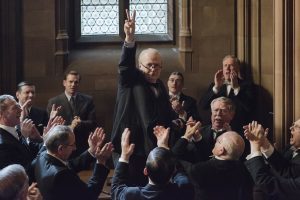
Even in the face of opposition from his fellow legislators, British Prime Minister Winston Churchill (Gary Oldman, center) rallies support for his agenda in “Darkest Hour.” Photo by Jack English, courtesy of Focus Features.
What’s more, Churchill had to realize he was not alone in this crisis, even though it may have felt that way at times. True, he had allies in his corner, such as his wife and secretary, but he needed to curry support from a broader base. And, to do that, he had to ask for that assistance, making a case for his position and tapping into our inherent connectedness to draw upon the power of co-creation. By doing so, he was able to engender the aid of collaborators to help him materialize the outcomes he sought. It proved to be an effort that a grateful England and Europe would come to appreciate and implement. Had it not transpired that way, we’d likely be facing a world with a very different look today.
Oldman’s stellar portrayal of the legendary leader is handily the greatest strength of this biopic, an effort that has earned him best actor nominations in the Golden Globe, Screen Actors Guild and Critics Choice Award competitions. However, despite the outstanding performance by the protagonist and several of the picture’s supporting players, the overall product is at times a little too talky and drawn out to captivate, given that it’s based on an epic story that truly should engross viewers. With a little too much emphasis on British domestic politics, the film sometimes becomes bogged down and, frankly, a bit boring. Still, despite this shortcoming, “Darkest Hour” has been well-received by critics, as evidenced by the three additional Critics Choice Award nominations that it has captured, including best feature.
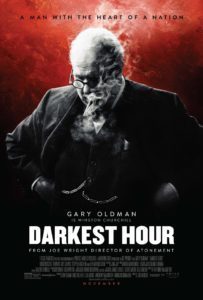
Icons deservedly attain the status they achieve as a result of their Herculean efforts. And, based on what’s depicted here, it’s easy to see how Churchill earned such standing. His experience sets an example we can all follow when we find our own backs up against the wall. We just might come away from such experiences finding ourselves rising to our own greatness – and beyond.
Copyright © 2017, by Brent Marchant. All rights reserved.
The post ‘Darkest Hour’ inspires us to rise to our own greatness appeared first on Brent Marchant.
December 26, 2017
Check Out Self Discovery Radio
Here’s a little gift just in time for the holidays! Join me and host Sara Troy for the current edition of Self Discovery Radio in which we discuss conscious creation in the movies, particularly as covered in my new book, Third Real: Conscious Creation Goes Back to the Movies. The interview is available as the featured podcast for the next week and will be subsequently archived on the show’s web site. Tune in for some fun and lively movie chat by clicking here.
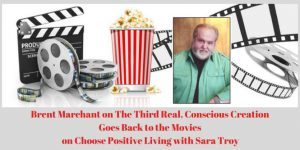
The post Check Out Self Discovery Radio appeared first on Brent Marchant.



